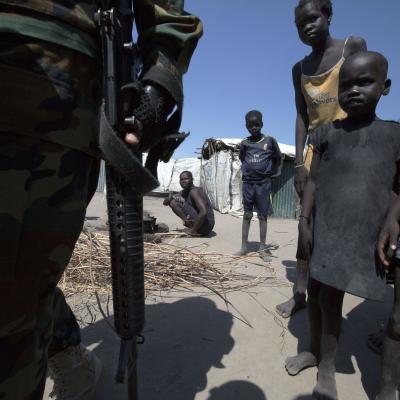Countries affected by conflict and fragility receive 64% of global aid, but it’s too often spent on fire-fighting, rather than the underlying causes of fragility, according to OECD experts. Capacity4dev hears from the authors of the latest OECD States of Fragility report about their new methodology for defining fragility, findings and recommendations.
By 2030 over 60% of people living in poverty will also be living in fragile, conflict-affected states. That makes understanding the causes of violence and fragility an increasingly urgent question for the development community. Rachel Scott, Team Leader on Fragility, Conflict and Resilience at the OECD, adds two more reasons. “One is the rise of violent extremism within our borders. The terrorist attacks our Member States experienced at home have given it a higher profile. A lot of causes of those acts are in fragile contexts, so there’s a drive to reduce them.”
Second: “to be blunt, a lot of it is about the refugee flows,” said Scott. “It’s a huge issue in Europe, and addressing those and tackling the popular sentiment that they should be halted, whether or not you agree with that, is driving a lot of our foreign policy at the moment, and the way our development budgets are asked to be spent.”
New framework
The latest OECD report represents a shift in the institution’s understanding of fragility, from defining it to studying it more broadly. The institution’s previous annual reports on the subject produced a list of fragile states and focused on resource flows and trends. “The problem with the list method is it’s binary, either fragile or not,” said Jorge Rivera, Policy Analyst at the OECD. “But there’s no direct way to assess fragility; it’s easier to identify than to measure, but there is no easy threshold beyond which a country is fragile.”
So how does the new report measure it? “Fragility is complex, a spectrum all the way up to stable with elements of fragility,” said Rivera. “So we moved to a universal, multidimensional framework.” Using a wide range of indicators, including World Bank and UN data, the report brings together five sets (“dimensions”) of indicators, for political, societal, economic, environmental and security risks and coping capacities. It allows users to compare 171 country situations across those five areas.
In the following video, Rachel Scott outlines the key findings of the report:
Rivera emphasised that although the report is a milestone, there is still some way to go towards data completeness. “28 countries and territories are not in the report because they had under 70% data completeness – the cut-off point. Most of these are Small Island Developing States, plus others like Western Sahara, and one in Central America.”
Then, even in countries with adequate data to make the report, “we only have national aggregated data, so can’t see where issues spill over borders or where there might be sub-national pockets of fragility, as the macro and micro levels are missing,” said Rivera. With violence increasingly recognised as a regional problem, “A massive effort is needed to collect better sub national data, and there’s a plea to use development support to build capacity for data collection,” said Rivera.
Middle income country fragility
One key change in the methodology, compared to previous editions, is that income level is no longer a determining input in defining fragility. As a result, the majority of the fragile contexts identified - 29 of the 56 - are middle income countries. “Something we haven’t thought about enough in the past is how to deal with that,” said Scott.
“The inherent assumption is often that economic growth equals peace, that you can develop your way out of conflict,” explained Sara Batmanglich, peace and conflict advisor at the OECD. “We now know that development and violence are not mutually exclusive. We need to go back to the drawing board, and think about how development can occur more equitably.”
This is especially important in the context of development aid reductions for ‘graduated’ countries, and increased focus on leveraging aid to bring in private sector investment. “It’s nice to see that the development finance context has come a long way, with a wider landscape of financing options, tools and instruments,” said Batmanglich. “But most fragile contexts don’t have so many options. Development and aid money are still very important, and that gets lost in the conversation about the private sector.”
Spending more effectively
An enormous amount of money – $2.04 trillion from 2004-14, a third of which is ODA – flows into countries affected by conflict and fragility, but it’s unevenly distributed, according to the report. “A lot is being spent on firefighting, and there’s quite a lot of work on building basic services and infrastructure,” said Scott. “But building social capital, social cohesion - those harder to do, intangible, long term aspects - are often forgotten. And they’re important for building, maintaining and stabilizing peace. Even sectoral programming, like for water – can be used to build social cohesion, build political voice.”
The long term social aspect should be prioritized by development and humanitarian programmes, according to Scott. “Different fragile contexts are fragile for different reasons, and we need to invest in analysis up front - why a particular context is fragile, and what are the different dimensions of fragility,” said Scott.
The next question is how this information can inform development programming. The report puts forward a number of recommendations, emphasizing that changes are needed both within donors’ borders and in their development cooperation.
|
Key recommendations: What OECD countries can do at home:
and in development cooperation:
|
The key to bringing the report’s recommendations into programming may be an obvious point, but still worth stating, according to Batmanglich: working with the communities themselves. “We can come with an outsider perspective – our and their understanding of the challenges may differ,” said Batmanglich.
“If we have a capital-based conversation, we tend to focus on terrorism and extremism. But in the field it’s not always regarded as the main issue, rather a symptom,” said Batmanglich. “For example in our recent Resilience Systems Analysis in the Sahel, when we did our background research on drivers, we pegged violent extremism and radicalization very high; yet on the ground it’s seen as a concern, but the real issue of youth not feeling that development delivers for them is seen as a more insidious threat.”
“And often we were surprised by the positive role played by groups tagged as ‘vulnerable’, when they’re engaged and empowered. And the role of religion – international actors can miss the stabilizing influence of modern Islam, its values, as a stalwart against radicalization.”
“To be honest, we’re not seeing great examples of the pieces fitting together in any one development programme,” said Batmanglich. “There are elements, but it’s rare to see them in one. There’s no perfect programme.”
That’s something the 2017 edition will pick up. “This year and next year we will be looking at the way different types of programming in different contexts can address different forms of violence, and how we can share that knowledge a lot more with the different member states,” said Scott.



Log in with your EU Login account to post or comment on the platform.